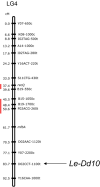A novel gene, Le-Dd10, is involved in fruiting body formation of Lentinula edodes
- PMID: 36063239
- PMCID: PMC9444836
- DOI: 10.1007/s00203-022-03206-z
A novel gene, Le-Dd10, is involved in fruiting body formation of Lentinula edodes
Abstract
The cDNA library prepared from Lentinula edodes, Hokken 600 (H600), primordia was screened using cDNA expressed specifically in Dictyostelium discoideum prestalk as a probe. Twenty-one clones, Le-Dd1 ~ 21, were isolated from the L. edodes primordia cDNA library. Functional analysis of each gene was carried out by transformation into protoplast cells from L. edodes Mori 252 (M252) mycelia with the overexpression vector pLG-RasF1 of each gene because M252 protoplast cells were transformed with an 11-fold higher efficiency than H600 cells. Transformants with the overexpression vector of Le-Dd10 formed a fruiting body at almost the same time as H600, a positive control, although M252, a negative control, did not form a fruiting body under culture conditions. This suggested that Le-Dd10 is involved in the formation of fruiting bodies. Single-strand conformation polymorphism analysis revealed that Le-Dd10 is located on No. 4 linkage group of L. edodes. The properties of Le-Dd10 products were investigated by Western blotting analysis using polyclonal antibodies against GST:Le-Dd10 fusion proteins. As a result, 56-kDa, 27-kDa, and 14-kDa protein bands appeared in primordial and fruiting body stages, although the expected molecular weight of the Le-Dd10 product was 50 kDa.
Keywords: Dictyostelium discoideum; Fruiting body; Shiitake mushroom; Transcription factor; Transformation.
© 2022. The Author(s).
Conflict of interest statement
The authors declare no conflict of interest. All experiments performed in this study complied with the current laws of Japan.
Figures







Similar articles
-
The fruiting-specific Le.flp1 gene, encoding a novel fungal fasciclin-like protein, of the basidiomycetous mushroom Lentinula edodes.Curr Genet. 2007 Jun;51(6):367-75. doi: 10.1007/s00294-007-0133-2. Epub 2007 May 3. Curr Genet. 2007. PMID: 17476508
-
Overexpression and repression of the tyrosinase gene in Lentinula edodes using the pChG vector.J Biosci Bioeng. 2019 Jul;128(1):1-7. doi: 10.1016/j.jbiosc.2018.12.013. Epub 2019 Jan 23. J Biosci Bioeng. 2019. PMID: 30683592
-
Isolation and transcript analysis of two-component histidine kinase gene Le.nik1 in Shiitake mushroom, Lentinula edodes.Mycol Res. 2008 Jan;112(Pt 1):108-16. doi: 10.1016/j.mycres.2007.08.024. Epub 2007 Nov 21. Mycol Res. 2008. PMID: 18234485
-
A cDNA homologue of Schizosaccharomyces pombe cdc5(+) from the mushroom Lentinula edodes: characterization of the cDNA and its expressed product.Biochim Biophys Acta. 2004 Oct 21;1680(2):93-102. doi: 10.1016/j.bbaexp.2004.08.009. Biochim Biophys Acta. 2004. PMID: 15488989
-
Cultivation methods and biology of Lentinula edodes.Appl Microbiol Biotechnol. 2025 Mar 11;109(1):63. doi: 10.1007/s00253-024-13387-w. Appl Microbiol Biotechnol. 2025. PMID: 40067479 Free PMC article. Review.
References
-
- Fujimoto Y, Nakagawa T, Tanesaka E, Yoshida M. Construction of Lentinula edodes expression vector and the expression system. Kinki J Crop Sci Breed. 2004;49:9–11.
-
- Hamada S, Tanesaka E, Yoshida M. Functional analysis of genes involved in fruit-body formation of Lentinula edodes. J Crop Res. 2008;53:67–73.
MeSH terms
LinkOut - more resources
Full Text Sources
Research Materials
Miscellaneous

